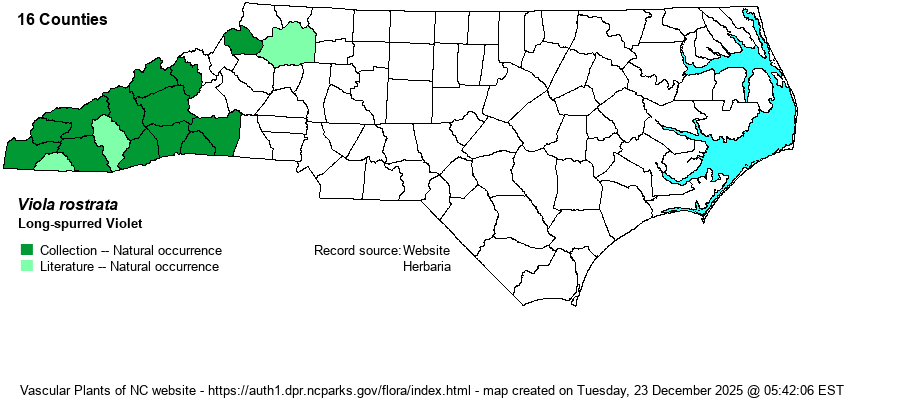| Author | Pursh | |
| Distribution | Essentially throughout the southern half of the Mountains, but inexplicably scarce in the northern Mountain counties, with only Watauga represented by specimens. Also in foothills (Piedmont) of Rutherford and Polk counties.
This is a Northern species, ranging from NH and WI south to PA and IN, and south through the Appalachians to central AL. Its scarcity in the northern half of the NC mountains makes little sense based on the overall range map as shown in BONAP. | |
| Abundance | Uncommon and somewhat local in the southern half of the Mountains, but very rare northward. Rare in upper Piedmont. | |
| Habitat | This is a species of acidic soils, though in rich to somewhat rich sites. It grows in Acidic Cove Forests, other hardwood-conifer forests, on wooded roadbanks, and other similar sites, often near hemlocks or rhododendrons on lower slopes. |
| Phenology | Blooms in April and May, and fruits shortly after flowering. | |
| Identification | This is one of the most distinctive violets, and a favorite to mountain wildflower enthusiasts, despite it not being numerous. It is a caulescent species, with the leafy stem reaching about 6-8 inches tall. The leaves are heart-shaped with an obtuse to somewhat acute tip, about 1-1.5 inches across and long. It has striking flowers, being lavender-blue but with a very elongated spur, typically 1/2-inch long, much longer than the spur on other violets. All petals are beardless, whereas the somewhat similar V. labradorica has bearded lateral petals and a spur reaching only 1/5-inch long. Also, V. rostrata flowers tend to have a dark blue center, as opposed to medium to light blue in the other species. This species is mysteriously scarce in the northern half of the mountains. Based on specimen records, it is most frequently found near the TN border, from Madison County southwest to Graham County. | |
| Taxonomic Comments | None
General note on Viola: In 2009-10 B.A. Sorrie (website map editor) went through the whole collection at NCU, annotating all specimens against those verified by experts in the genus. The range maps in RAB (1968) have been changed accordingly. More recently, Harvey Ballard and colleagues are in the process of revising all Eastern and Southeastern Viola, and have annotated all specimens at NCU in July 2024. They recognize additional species not in RAB or in previous editions of Weakley et al.; we will follow updated editions of Weakley et al. in recognizing them. Species range maps have been adjusted to account for identification changes. | |
| Other Common Name(s) | Spurred Violet, Longspur Violet | |
| State Rank | S3 | |
| Global Rank | G5 | |
| State Status | | |
| US Status | | |
| USACE-agcp | FACU link |
| USACE-emp | FACU link |

